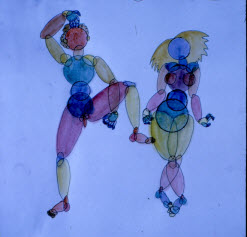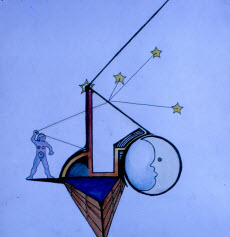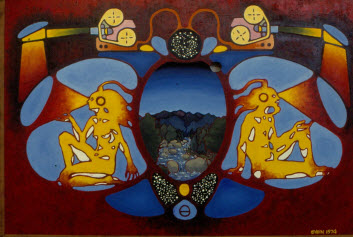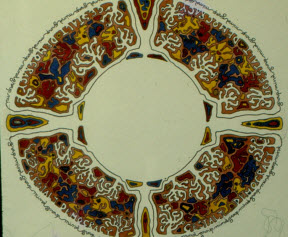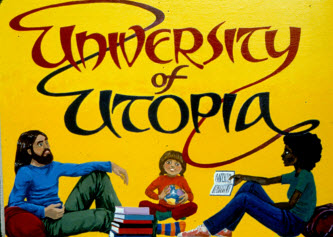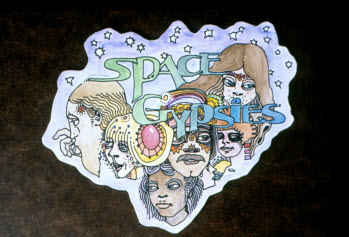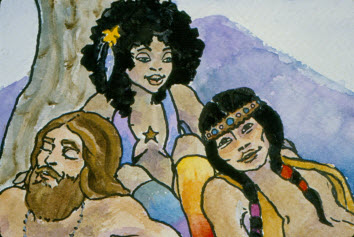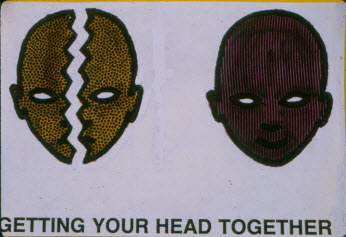Kerista Menu
|
Kerista Articles - History of the Kerista Commune
History of the Kerista Commune
from the "Kerista Village Handbook" February 1979
Kerista Village dates back to February 1971, when Brother Jud and Even Eve met
each other for the first time. Kerista itself, however, has a longer history that traces
back through several earlier phases...
The work Kerista itself came about through a mystical experience, quite uncalled for, in the mind of Jud
back in 1956. The word, and the accompanying experience, were enough at that time to jolt Jud
out of his fairly straight lifestyle and propel him into a search for meaningful religiousness
and communal living. In 1956 both were in rather short supply. In close to a dozen different
experimental attempts, Jud, along with others he met, tried to establish a viable communal lifestyle.
Before long the quest has become closely intermingled with the idea of Utopian Paradise; several
of the experimental groups occurred outside the United States on islands (Ibiza, Dominica, Roatan).
Before long too, the utopian notion had begun to verge towards something other than monogamous
family units. During what was perhaps Kerista's best known period, prior to Kerista Village,
it became the name of a widespread hippie 'flower tribe' that operated communal houses and free
stores from New York's Lower East Side to the West Coast. This was during the 1960's. Free love and
chemical highs were big in those days, and the Keristan philosophy did much to amplify such hedonistic
pursuits. We still meet people today who remember people from that era, who are very surprised to find
that it still exists in the first place, and in the second, that not very much of the live-for-the-moment,
sensual philosophy is now Keristan.
None of the experiments took. Each and every communal setup eventually came to an end,
and Jud, still a believer, went on looking for the next one, one that would hold together.
The difficulty was never external pressure or problems, the unraveling influences in every case
were internal and psychological. People could not live together harmoniously. The reasons, as the years
ticked by, mounted up. Coupling, promiscuous sex, pets, tightwadism, rivalry ... slow by slow,
Brother Jud was learning the ropes, by trial and error.
Meanwhile, the sixties came to an end, and back across the country (Jud was now in the Haight-Ashbury)
another Utopian mind was stirring to life. In an obscure, loosely communal household in Vermont, Even Eve
was having her first taste of 'liberated' life. Recently out of high school, she had decided that people,
relationships, and a mysteriously compelling vision of some sort of model communal scene were of higher value
than the expected course of college, career, and marriage and so she had planted herself in one of the first
communal settings she could find ... After giving the Vermont scene her best, Eve decided to head for ...
San Francisco, and make a new start.
Then one bright February day, following a phone call made in response to a notice in a Free University catalog,
Eve walked up the stairs to a flat where Jud was living, the base camp for his still-fictitious Utopian community
... and lo and behold, the two energy forces from which Kerista Village was born met head-on in their collision course,
and the real experiment began.
By mid 1971, Way, (a friend of Eve's from high school) had joined forces with the Keristans, adding her inimitable,
exuberant, thatrical style to Jud's theoretical and Eve's artistic genius. The three of them (plus a couple of others
who didn't stay with it) formed the first "LSR" (Living School Residence Group) later to be referred to as a superfamily,
then as a PCG (polyfidelitous closed group), then as a BFIC (Best Friend Identity Cluster, pronounced 'bee-fic'),
the appelation currently in use. They called it "The Purple Submarine". The group advertised by means of posters, fliers,
newspaper notices, letters to friends and relations. word-of-mouth and personal contact in the form of pick-ups ...
chance meetings with strangers who 'looked like they could do it.' (All those outreach methods by the way,
are still in use, except for the pick-ups, which proved 100% of the time to go nowhere and rip off time and energy)
They held regular rap groups, invited newcomers to come over and hang out, lectured and performed original music and
theater to communicate their message and recruit more members. For some reason people always had the impression
that there were more than four or five people involved ... must be comething in the grandiose way they talk ... The
Keristans were never ones to believe in 'letting it happen.' The Cosmos might have it all worked out already,
but you still had to put out that effort to deserve your rewards.
After about a year and a half of these efforts came another big score in the form of Geo Logical. Geo, a psychiatric nurse
dropped out in search of a real cure for the many ills of the world (her own life included) came in by way of Gestalt-o-Rama
rap groups that were being held twice a week. ... Geo's passion for psychology thrown into the mix paved the way for Utopian
Psychology, a science of human happiness ... a psychology that looked at people in ideal rather than unnatural and
anxiety-breeding situations. Utopian psychology postulated a theory of positive human 'instincts' which (the theory continued)
if properly supported by the environment, would prosper and produce balanced, contented, productive people. The trick
was to design the right environment and make it work .. .hence the image of Kerista Village (thought that name had not yet been
born) as a social laboratory, a live-in test tube.
The four first members continued steadfastly in their many efforts to grow, trying one thing and then another, meeting hundreds
of people, articulating the trip and its developing ideas thousands of times, learning how to answer all the questions and scoffs
they ran into. Few people could get the picture at all, let alone believe it would ever really work if they did. In 1973, they
started the Storefront Classroom, a free newspaper featuring articles on ecology, nutrition, psychology and alternative technology,
comics ("Far Out West" by Even Eve) and a directory of San Francisco stores and resources. The paper was a success, both economically
and in terms of local popularity. A year or so later they put out the first issue of Utopian Eyes magazine, which focussed on
the esoteric issues of lifestyle, communal living, and the ins and outs of Keristan theory and practice. Both of these publications
are alive and well still.
Beginning in 1976, prospects began to look up a little ... a few more people trickled into the Keristan scene ...
1977 saw the population grow to about twelve stable people...1978 saw it grow to a temporary high point of 30 people and
then contract back down to a solid eighteen ... The bigger numbers also gave Kerista Village (the name came in '78)
a real dimension of community for the first time, instead of only one little family cluster with fine intentions. Several
new BFICs were started in addition to the Purple Submarine, establishing that even among close friends with identical ideals,
subtle personality differences would mark people as being cut out for different families. The community spread to four large
flats in San Francisco, seminars and conferences were held; new work collectives were established with success; the surplus
income sharing system (project SISTER) came into being; Kerista Consciousness Church was legally incorporated, Sister
Kerista (a black hippie goddess, sister of Brother Jesus) made her premiere appearance in Far Out West Comics; the Utopian Art
Theater got off the ground, along with a Traveling Gestalt Caravan; traditions and spontaneous rituals of celebration,
courtship, and Utopian etiquette were greatly evolved, the original social contract (first drafted in 1974) went through
nice changes, the first baby (due in Mid '79) was conceived, in short, a lot was happening.
| |
